Free Shipping on Orders over $75 to the Contiguous US
Free Shipping on Orders over $75 to the Contiguous US
Growing Tulips for Cut Flower Production
September 02, 2025 7 min read 0 Comments
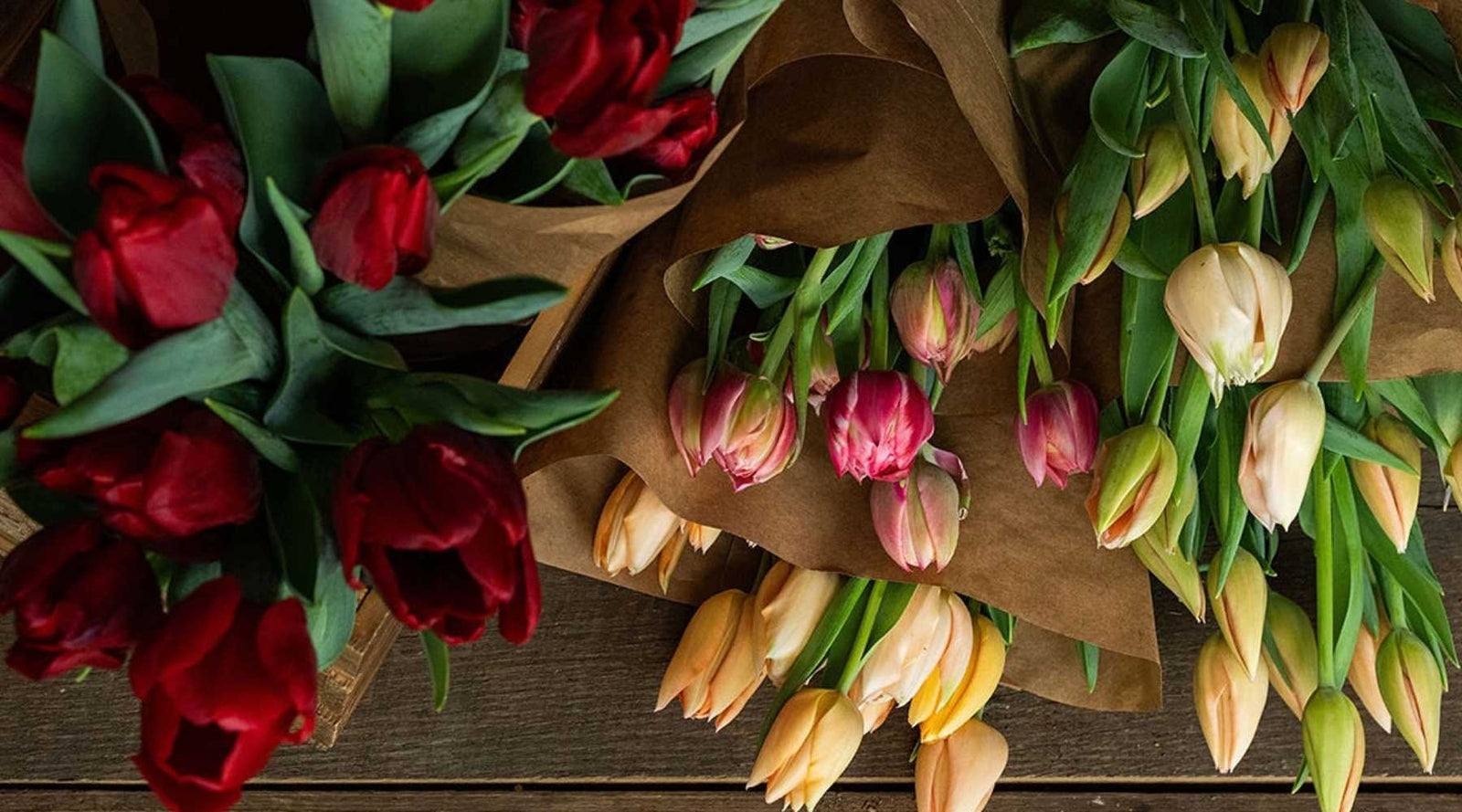
How to Grow Tulips for Cut Flowers
Tulips are a popular perennial garden flower, but did you know growing tulips for cut flowers differs significantly from growing for the garden?
From the types of bulbs you choose to how you plant, we’ll show you how to successfully grow tulips for cutting.
Why Should a Flower Farm Grow Tulips?
Tulips are popular with flower farmers for several reasons. First, they are among the earliest blooming flowers you can grow. When timed right, you can have fresh tulips available for Mother’s Day, one of the biggest flower holidays of the year. Having flowers available can mean making a lot of money during a season that often has little to no other income.
Tulips also demand a high price per stem (retail and wholesale). If you choose more unique tulip varieties (more on that below), you can charge $3-$5 per stem.
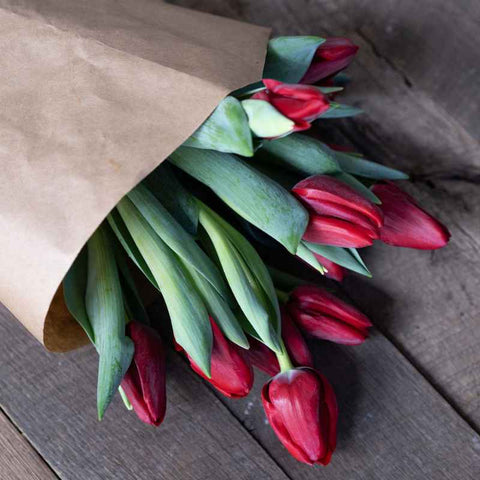
At the latest, tulips will also be entirely done by the end of May. This means you can turn over those beds and use them for summer seedlings. Getting more use out of the same space is one of the best ways to maximize your profits on a small farm. If you are planning to grow in a high tunnel be sure to look into other cut flowers you can grow in there once the tulips are done.
Why Should a Flower Farm NOT Grow Tulips?
There are a few reasons you may want to avoid growing tulips. First, selling them during April and early May can be challenging if you do not have a developed customer base. Many farmers' markets open later than that, so you need to have some direct links to customers in place.
Second, while you can make a lot of money by having flowers available for Mother’s Day, it’s also extremely challenging to hit a particular bloom date accurately. We know many seasoned farmers who have given up on tulips because the stress of getting them to bloom for one weekend was just too much.
Lastly, tulip bulbs aren’t exactly cheap. Expect to pay anywhere between 50 cents and $2 for bulbs. If you’re planting thousands of flowers, this can quickly add up. You can certainly make your money back if you sell them all, but like we said above, be sure you have an established sales outlet before planting tulips.
How to Choose Tulips for Cut Flowers
It’s critical to note that you need to purchase cut flower varieties. These types of tulips are developed for longer stems and a better vase life. Look for those with stem lengths of 16 inches or more. The longer the stem the more versatile a tulip is for arranging.
Popular places to order wholesale cut flower tulips are Ball Seed and Rotteveel Bulb Co. Other companies that offer smaller order sizes with comparable pricing include Longefield Gardens, Brent and Becky’s, and Breck’s.
As you browse cut flower varieties, you’ll see so many different kinds that you’ve never seen available at your local grocery store. By choosing more unique offerings, you’ll have a competitive advantage. We’ve found the double and fringed varieties to be particularly popular.
Among our favorites are Foxy Foxtrot, La Belle Epoque, Renown Unique, and Parrot Negrita. When choosing bulbs, be sure to look for longer stem lengths. This is one area where tulips often struggle, and it’s a shame to plant a bunch of tulips that only get 4 inches tall.
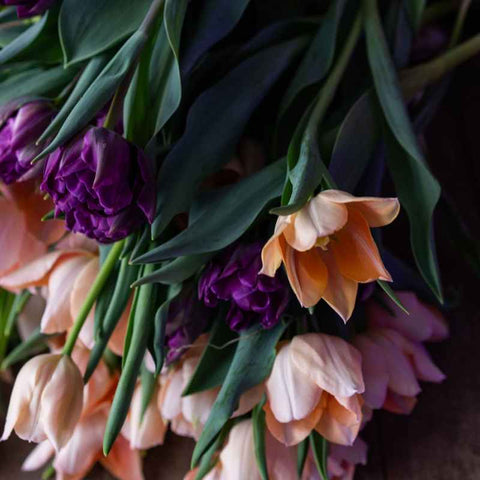
How to Plant Tulips for Cutting
Planting tulips for cut flowers is very different from landscape plantings. You’ll find you can grow them closer together since this helps encourage tall growth. Many farmers plant directly in the ground, but it’s also very popular to plant in crates either in a greenhouse or outside. Below, we’ll cover both options.
Cat tunnels or low tunnels covered in frost blankets can also be used to speed flowering times in cooler climates. For more information on Protecting Crops from Frost you can review this article. While in-ground bulbs are not very susceptible to frost you will want to protect buds from late cold snaps.
Note that tulips need proper chilling time. If you have cool winters and are planting in fall, then you don’t need to do anything. If you live in a warmer climate, you may need to purchase pre-chilled bulbs.
Planting Tulips in the Ground
Instead of digging a single hole for each bulb like you do when planting in the garden, you will dig a long trench. Dig at least 6-8 inches deep; the deeper they are, the longer the stems will be.
Once your trench is dug, place the tulips in next to each other. Pointy side up always. Imagine eggs in a carton; that is the type of spacing we’re going for here. If you’re planting different varieties, be sure to place markers where they type changes.
Once all the bulbs are in the trench, give the bulbs a good soaking. Then, cover with soil or compost. If you have a lot of rodent pressure, you’ll also want to cover the bulbs with aviary wire to prevent them from digging up your bulbs.
Gophers and voles can also cause damage to bulbs. You can abate this by lining your trench with hardware cloth or aviary wire. We also suggest DIY low tunnels as the tulips grow larger for protection. Easily cover them with hardware cloth or greenhouse plastic for protection. Alternatively, you can plant your tulips in crates as outlined below.
That’s it; now it’s time to wait for spring.
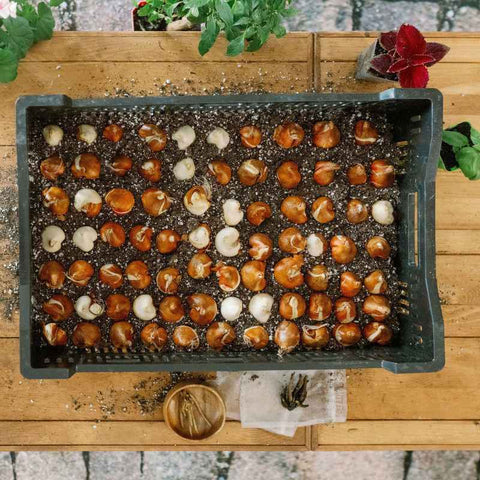
Planting Tulips in Crates
Planting tulips in crates is an excellent option whether you will keep them outdoors or in the hoop house. By planting in a crate, you don’t have to dig a trench, you don’t take up a garden bed for long periods, and you can move crates around to hit the desired bloom time.
To plant, first line the crates with newspaper or butcher paper so the bulbs don’t fall out. Then, put an inch or so of soil or compost in the crate. Next, place the tulip bulbs in the crate with spacing similar to an egg carton. Water lightly and fill the crate with soil.
Getting Longer Tulip Stems
Tulips are gorgeous, but they can have shorter stems, so it’s essential to do what you can to elongate them. The most crucial step is burying the bulbs deeply and packing the bulbs close to one another.
Next, once they start to sprout in the spring you can use shade cloth to help them grow taller. We've seen flower farmers shade cloth the entire hoop house or simply cover individual rows (similar to what we discussed when creating microclimates). The shade cloth encourages the flower to reach taller, looking for strong sun. It can also help cool the flower and delay blooming if you’re trying to hit a specific date.
Tulips can also be grown hydroponically indoors, where you can control their access to light and elongate the stems. To learn more about this method check out From Setup to Bloom: Your Step-by-Step Guide to Hydroponic Tulips.
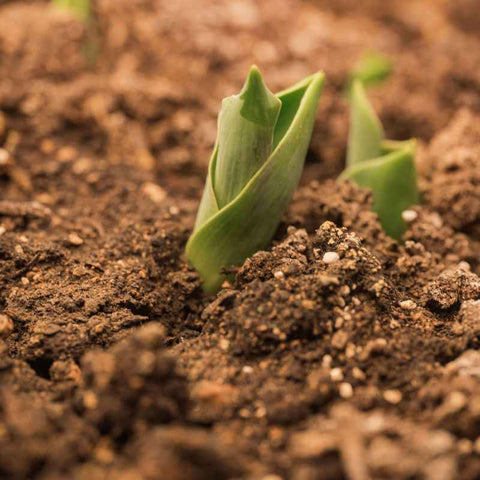
Tulips in Spring
Once the tulips start sending up green shoots, you can remove any rodent barrier and water once or twice a week as needed.
Your tulips are ready to harvest when the bud is colored and just on the brink of opening up. You'll have a slightly shorter vase life if you wait until it is fully open.
Harvesting Tulips
Cut flower tulips are treated as annual. Instead of cutting the stem to harvest, the entire bulb is pulled up. This allows you to get a longer stem by using what was underground.
To harvest, loosen the soil around the tulips. You can do this with a pitchfork, broadfork, or shovel. Just take care not to damage tulips or pierce bulbs.
Grab the tulip stem at the base and wiggle loose. It gets easier as more tulips are pulled and space is opened up.
Storing Harvested Tulips
Another benefit of pulling the entire bulb is the long storage life. Since the flower still has its nutrient source, you can store a tulip in the cooler for a couple of weeks. This flexibility is great if you’re looking to sell on Mother’s Day or need time to prepare for a subscription delivery or market.
For this method, you will be storing the flower out of water. Simply lay the tulips (with the bulb attached) in a tulip crate. You can also wrap in paper and stand up in a harvest bucket. Place in the cooler until you are ready to use.
When you’re ready to use your tulip, cut off the bulb and place the stem in cool water. Tulip stems tend to get a bit floppy, but you can straighten them out by wrapping bunches in a paper cone. Note that tulips extend once hydrated, so if you’re using them in an arrangement, place them deep, knowing they will gain an inch or two.
Cut Flower Tulip Vase Life
Farm fresh tulips can easily last 1-2 weeks in the vase. Change water regularly and keep out of the direct sun to extend their life.
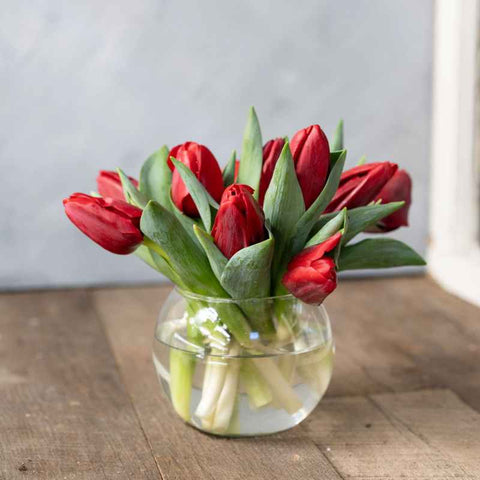
Conclusion
Tulips can be a great addition to the farm (if you have a way to sell them!). They offer up a cheery bunch of blooms and a nice influx of cash early in the season. They also demand a premium price and, when timed properly, can align with one of the biggest flower holidays around.
The abundance of unusual tulip varieties and long vase life make them an excellent addition to the flower farm or cutting garden.
FAQ about harvesting tulips for cut flowers.
How do you keep cut tulips from drooping?
Tulips naturally get a bit droopy after cutting. Wrap them securely in paper and place them in cool water to remedy this. If your home is warm, it can also help to place them in the fridge. Once they are cooled and rehydrated, you can remove the paper and enjoy your straightened stems.
Do tulips regrow after cutting?
If you’re harvesting tulips for cutting, you’ll most likely pull the entire bulb. But if you want to cut a few garden beauties to enjoy, cut a shorter stem and don’t cut the outer green leaves. The tulip will regrow if it has enough nutrients to use in the plant. The flower next year probably won’t be as large, though.
How close to plant tulips for cut flowers?
Imagine eggs in a carton; that is the spacing you are going for when planting tulips for cut flowers.
Do tulips make a good cut flower?
Yes, tulips make good cut flowers. They come in many colors and styles, are popular with customers, demand a high price, and can be available on Mother’s Day when flower buying is rampant.
How long should tulip stems be for cut flowers?
Stems that are at least 16 inches are ideal, taller is better. Many garden varieties will be 12 inches or less so you will want to look for the tallest types you can find. When purchasing bulbs for cut flower production, keep in mind that the listed heights are a range and depending on your growing conditions they could end up shorter than listed.
Resources:
https://extension.umd.edu/resource/production-tulips-cut-flowers
Subscribe
Sign up to get the latest on sales, new releases and more …

